#asteroid near earth
Text
NASA says three asteroids will pass Earth by a close margin today; Check speed, size and more
Just yesterday, 3 asteroids passed Earth by a close margin. While none of them were considered “Potentially Hazardous Asteroids”, the biggest of them was 150 feet wide, making it almost as big as an aircraft. Such close approaches by celestial objects such as asteroids and comets serve as a reminder of the dangerous potential they possess and the need to continuously monitor their trajectories.…
View On WordPress
#Asteroid 2024 EO3#Asteroid 2024 FN1#asteroid belt#asteroid earth#asteroid launcher#asteroid nasa#asteroid near earth#asteroid strike#asteroid today#asteroids#asteroids near earth#busC#earth#latest asteroid#NASA#nasa asteroid#NASA asteroid 2024 EO3#NASA Asteroid 2024 FN1#nasa asteroid today#near earth asteroids#near earth objects#two asteroids
0 notes
Text
House-sized asteroid hurtling towards Earth for close approach, NASA reveals
With its advanced tech such as the NEOWISE telescope, Atacama Large Millimeter/submillimeter Array (ALMA), Pans-STARRS1 and Catalina Sky Survey, NASA has revealed details about an asteroid that will come close to Earth. An asteroid, given the designation of Asteroid 2023 TC1, is on its way towards Earth and could make its closest approach to the planet today, October 13.
NASA has tracked this…

View On WordPress
#Asteroid#Asteroid 2023 TC1#asteroid belt#asteroid earth#asteroid launcher#asteroid NASA#Asteroid near earth#asteroid strike#asteroid today#asteroids#asteroids near earth#Earth#latest asteroid#NASA#NASA asteroid#NASA asteroid 2023 TC1#NASA asteroid today#near earth asteroids#near earth objects
0 notes
Text
Alert! 290-feet wide asteroid 2022 KY4 to approach Earth first time in 100 years
Alert! 290-feet wide asteroid 2022 KY4 to approach Earth first time in 100 years
Asteroid 2022 KY4: Asteroids have once again started making close approaches to the Earth’s surface. Earlier, the National Aeronautics and Space Administration (NASA) found a small 41-feet wide asteroid nearing our planet and now astronomers have warned about the coming of a gigantic asteroid which is set to make its closest approach to Earth on July 17.
The asteroid, dubbed as 2022 KY4, is…
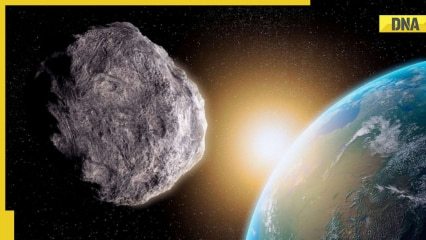
View On WordPress
1 note
·
View note
Text
In the wee morning hours on Sunday (Jan. 21), a tiny asteroid came hurtling through the sky and smashed into Earth's atmosphere near Berlin, producing a bright but harmless fireball visible for miles around. Such sightings typically occur a few times a year — but this one was unique because it was first detected by scientists roughly three hours before impact — only the eighth time that researchers have spotted one of these space rocks before it hit.
The asteroid, dubbed 2024 BXI, was first discovered by self-proclaimed asteroid hunter Krisztián Sárneczky, an astronomer at the Piszkéstető Mountain Station, part of Konkoly Observatory in Hungary. He identified the cosmic rock using the 60-cm Schmidt telescope at the observatory. Shortly after the space rock's discovery, NASA gave a detailed prediction of where and when the meteor would strike.
"Heads Up: A tiny asteroid will disintegrate as a harmless fireball west of Berlin near Nennhausen shortly at 1:32am CET. Overseers will see it if it's clear!" NASA tweeted on the night of Jan. 20.
Continue Reading.
86 notes
·
View notes
Text
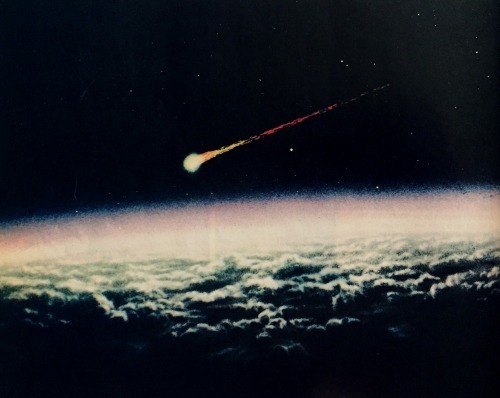
#asteroid#sky#space#astronomy#celestial#cosmic#celestial object#minor planet#near-Earth object#meteor#comet#solar system
33 notes
·
View notes
Text

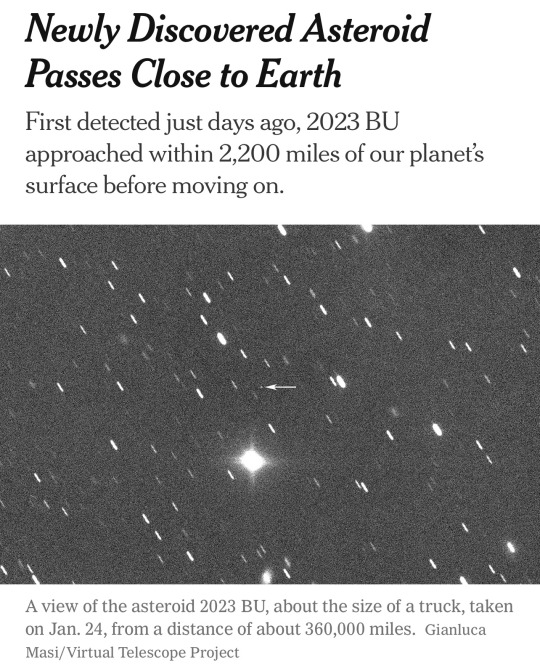
The path of Asteroid 2023 BU brought it between the Earth and some of our man-made satellites. (source)
88 notes
·
View notes
Link
“A new space-based surveyor that will help catalog millions of near-Earth objects is now ready for budgeting and building after passing a rigorous technical review.
This year NASA completed its first-ever mission organized entirely for the purpose of planetary defense, when the DART probe slammed into an asteroid to see if it could be redirected away from a potential collision course with Earth.
Now, the NEO Surveyor mission will discover and characterize at least 90% of the near-Earth objects more than 140 meters (460 feet) across that come within 30 million miles of our planet’s orbit.
These objects are capable of causing significant regional harm, while history has shown that larger ones can be catastrophic. Humanity has gotten lucky thus far, but slow-growing wisdom has seen NASA create a Planetary Defense Coordination Office for the purpose of learning how to protect Earth from such events...
“Ground-based telescopes remain essential for us to continually watch the skies, but a space-based infrared observatory is the ultimate high ground that will enable NASA’s planetary defense strategy.”
Sitting around 1 million miles from Earth at the First LaGrange Point, NEO Surveyor will view the solar system in the infrared spectrum of light, lightwaves that are blocked by Earth’s atmosphere and therefore invisible for ground-based telescopes...
The launch date is currently proposed for June 2028.” -via Good News Network, 12/23/22
8 notes
·
View notes
Text


Adult science fiction standalone novel
In near-future America, struggling documentary filmmaker Hayes Figuerido learns that an alternate version of himself from a parallel universe created the Envisioner, a device that can predict the future, and sent it to his reality
When he joins a team of scientists studying the Envisioner, Hayes meets physicist Yusuf and learns the two of them are married in another universe and finds himself falling for Yusuf in this one
As Hayes learns more about the multiverse, however, it becomes clear that while their lives are inextricably linked, their story often ends in tragedy and saving Yusuf could risk the univerise
Explores multiverse theory and questions of how far you will go to save the one you love
Gay main character with depression; Egyptian, Muslim love interest; M/M romance; aromantic asexual Japanese side character
#ooh i read this one a while ago let me try to remember what i thought#i think the first third or so when they're just studying the envisioner and yusuf and hayes are falling in love is a bit slow#enjoyed the multiverse-hopping stuff#some of the filmmaker stuff like envisioning the world as a script got a little tedious#well fleshed-out protagonist who feels very realistic and flawed#also i liked yusuf#i have seen at least one review by an autistic reader saying they read him as autistic#the aroace representation felt a little questionable to me because the character in question is very cold/calculating?#didn't expect that there would be so much world-building around the near-future america setting which was interesting#like androids being common and also an indigenous sovereign state#also there's one world with a movie crew stuck on the moon that i thought was super interesting#the alternate realities are all cool#okay BIG SPOILERS NOW#i was kind of unconvinced by the ending#basically the main character is given the choice between saving yusuf's life and letting an asteroid destroy earth in another reality#he picks yusuf and it like 'now to compartmentalize my horrific guilt and live happily with him'#and i was like. bro. you are going to be eaten alive by guilt in a few years#i don't know i wasn't convinced by it!!#would love to hear thoughts from someone else who has also read this book tbh#a fractured infinity#nathan tavares#2023 reads#books#lulu reads a fractured infinity#lulu speaks#lulu reads
4 notes
·
View notes
Text
DART All Set To Crash Into Asteroid Dimorphos
youtube
This animation depicts the asteroid moonlet Dimorphos being approached by DART and then crashing with it.
In order to demonstrate a method for diverting potentially deadly space rocks headed for Earth, NASA's Double Asteroid Redirection Test (DART) mission will deliberately crash a spacecraft with an asteroid on Monday.
The Double Asteroid Redirection Test, or DART, will collide with the asteroid moon Dimorphos on September 26 at 7:14 p.m. EDT (23:14 UTC). At 6:00 p.m. EDT, NASA TV will begin airing live coverage.
DART will be transmitting photographs every per second throughout the last hour of the mission when Dimorphos transforms from a point of light to an object that fills the full camera frame.
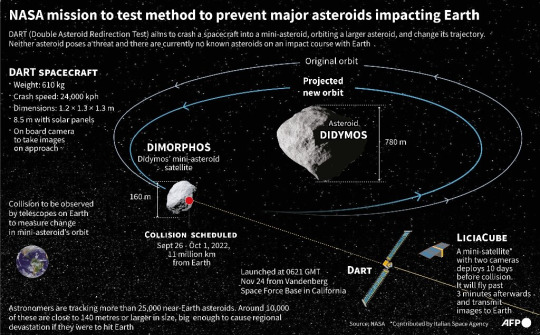
Dimorphos' orbit around Didymos, its bigger parent asteroid, will change as a result of DART's collision. This alteration will be visible to telescopes on Earth, providing proof that the test was successful.
DART's CubeSat will also monitor the impact, and the Hera probe from the European Space Agency will go to Dimorphos in 2026 to examine the crater it left behind.
For billions of years, asteroids have been colliding with Earth. Finally, mankind is responding, starting with DART.
Why is DART crucial?
An asteroid 6 miles (10 kilometers) broad that impacted the Earth 66 million years ago wiped off the dinosaurs and caused a worldwide extinction. Although some evade detection, we believe we have located the majority of asteroids this large, and none are headed directly for Earth.
But it doesn't take anything that big to wreak havoc. An asteroid that is just 50 meters (160 feet) broad has the potential to kill a lot of people under the appropriate circumstances.
Around 20 meters wide, the tiny asteroid that burst in 2013 near Chelyabinsk, Russia, injured 1,500 people and destroyed 7,200 structures in six towns.
Near-Earth asteroids, also known as near-Earth objects, are asteroids that pass by Earth on their orbits (NEOs). If we discover a dangerous NEO on path to strike Earth with enough time to spare, we may be able to gently push it off course.
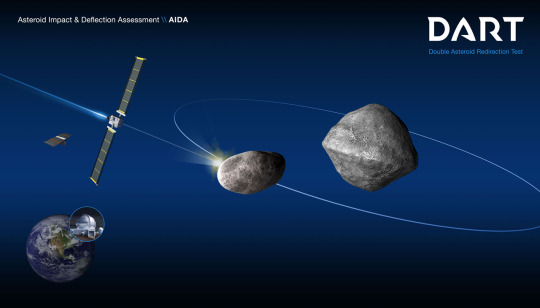
The kinetic impactor method is what is used in this. By crashing with the asteroid Dimorphos, DART will put this strategy to the test and demonstrate how an asteroid's orbit may be changed by a spacecraft.
When will DART have an effect on Dimorphos?
youtube
At 7:14 p.m. EDT on September 26, 2022, DART will affect Dimorphos (23:14 UTC). At 6:00 p.m., NASA TV will begin airing live coverage. The Johns Hopkins Applied Physics Laboratory in Baltimore, Maryland, is in charge of running the mission.
DART's last broadcasts will take 38 seconds to reach Earth at the speed of light. The spacecraft launched on November 21, 2021, and its 10-month voyage will come to an end with the hit.
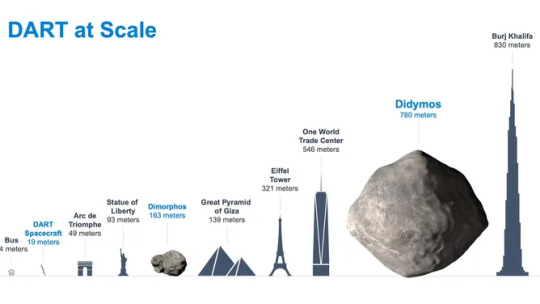
What will the closing minutes of DART entail?
Till the very last hour, and particularly the very last five minutes, we won't see anything.
Didymos and Dimorphos are already visible to DART, although they are still only a single point of light. DART is growing quickly, and Didymos and Dimorphos are both rather tiny cities. DART will approach Dimorphos at a scorching speed of 6.6 kilometres (4 miles) per second, whereas previous asteroid missions like Hayabusa2 at Ryugu and OSIRIS-REx at Bennu have featured leisurely approaches and plenty of beautiful photos.
Didymos is between Ryugu and Bennu in terms of size, being around 780 metres (2,560 feet) wide. Dimorphos, with just 160 metres (525 feet) wide, is smaller than both.
Four hours before to impact, the DRACO telescopic camera on board the spacecraft will begin sending photos to a group of navigational algorithms referred to as SMART Nav. The task of SMART Nav is to locate Dimorphos and manoeuvre the spaceship into collision on its own.
One of those photos will be sent to Earth every second or so. Although DRACO's detector has a resolution of 2560 × 2160 pixels, the pictures are reduced in size so that DART can relay them quickly—to only 512 by 512 pixels.
The DART crew and NASA TV will both see these photographs at the same time. What can we anticipate to see?
With an hour till impact, Dimorphos should finally be visible to DART as a distinct point of light, albeit one that is just a few pixels wide.
Both asteroids should still be visible in the camera frame four minutes before collision. Dimorphos will be roughly 20 pixels wide, whereas Didymos will be about 100 pixels wide.
Two minutes before impact: Dimorphos will be about 45 pixels wide, and it will be obvious that DART is approaching.
Terik Daly, the DRACO deputy instrument scientist, predicted that DART will be able to observe stones and rocks on Dimorphos as large as vending machines 20 seconds before impact. If everything goes as planned, Daly told The Planetary Society, "the last few milliseconds before impact will enable us to observe features on the surface with a pixel size of around ten centimeters (about 4 inches) per pixel."
Dimorphos will be completely vaporized when DART collides with it. Depending on the makeup of Dimorphos, the resultant crater might be as large as 20 meters (66 ft) across. The time it takes for signals to travel at the speed of light to reach Earth is 38 seconds by the time we see DART's broadcasts come to a stop.
How will we know if DART worked?
DART's success will eventually be determined by measurements made using ground-based telescopes.

Didymos and Dimorphos appear to Earth as a single point of light. As the two asteroids pass in front of one another, that point of light changes. This makes it possible to calculate Dimorphos' orbital distance from Didymos.
Dimorphos's orbital period should be shortened by the impact of DART from about 11.9 hours to 11.8 hours, demonstrating the effectiveness of the kinetic impactor method.
The Lowell Discovery Telescope in Arizona, Las Campanas Observatory in Chile, the worldwide network of Las Cumbres Observatory, and the Magdalena Ridge Observatory in New Mexico are just a few of the telescopes that the DART team uses for its studies.
What will the CubeSat for DART do?
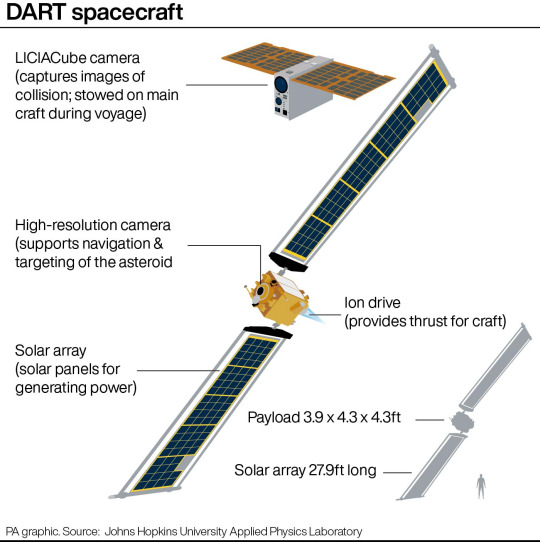
DART will launch a CubeSat called LICIACube, the Light Italian Cubesat for Imaging of Asteroids, about 10 days before impact.
The Italian Space Agency's LICIACube was created with the intention of observing DART's impact, the plume it produces, and maybe the resultant crater. It will use two cameras called LUKE and LEIA to do so from a distance of around 50 kilometers (31 miles).
You shouldn't anticipate LICIACube to send back photographs straight immediately since the CubeSat can only interact with Earth at modest data speeds, which might take months.
How will Hera look into the effects of DART?
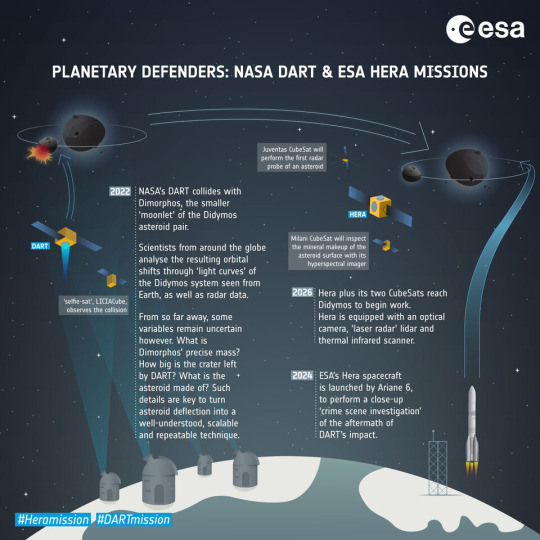
The European Space Agency will deploy a mission dubbed Hera in 2024 in order to thoroughly investigate what took place when DART collided with Dimorphos. Hera will land in 2026 with a collection of tools to explore Didymos and Dimorphos, particularly the impact crater that DART created. The spacecraft is equipped with a laser altimeter to produce 3D maps and an infrared camera to measure the temperatures of asteroids and learn more about their surface characteristics.
Additionally, Hera will launch two of its own CubeSats. Before trying to land on Didymos, Dimorphos, or both asteroids, they will investigate the innards of the asteroids.
What distinguishes DART from Deep Impact?
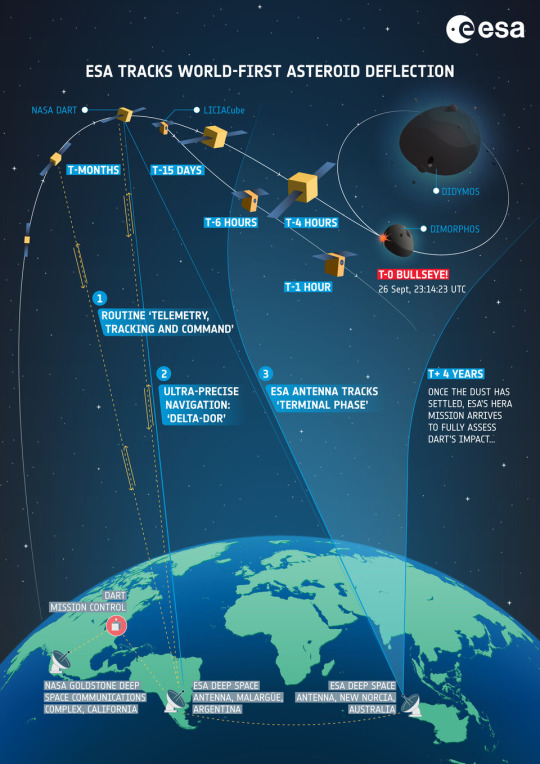
Planetary protection was not the goal of Deep Impact. The spacecraft, which had been launched in January 2005, hit Comet Tempel 1 on July 4, 2005. The comet likely originated from the Oort cloud, a ring of ice debris that surrounds our solar system, since the collision showed it to be around 75% empty space.
Deep Impact was given the new designation Deep Impact (EPOXI) and despatched to Comet Hartley 2 after completing its mission at Tempel 1. Extrasolar Planet Observations (EPOCh) and Deep Impact Extended Investigation make up the double-nested acronym EPOXI (DIXI).
After Hartley 2, NASA planned to deploy Deep Impact (EPOXI) to a third comet, however in August 2013, contact was lost with the probe.
What is the cost of DART?
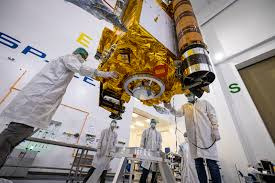
Costing $324.5 million is the DART mission. The spacecraft itself cost $308 million for NASA's planetary defense program, as well as $68.8 million for launch services and $16.5 million for operations and data analysis.
How else might asteroid strikes be avoided?
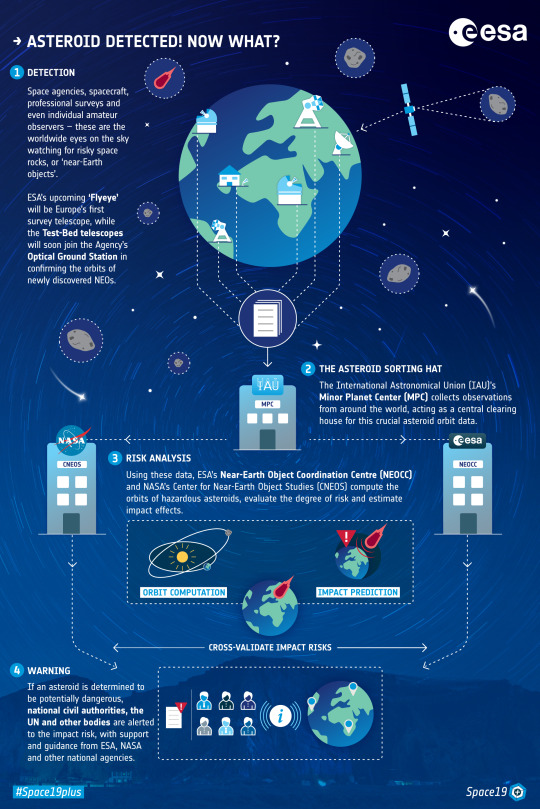
To prevent harmful asteroids from striking the Earth, a considerably bigger jigsaw must be pieced together than DART.
We must first look for nearby things. The fraction of asteroids we've discovered will increase significantly with the launch of the NEO Surveyor mission.
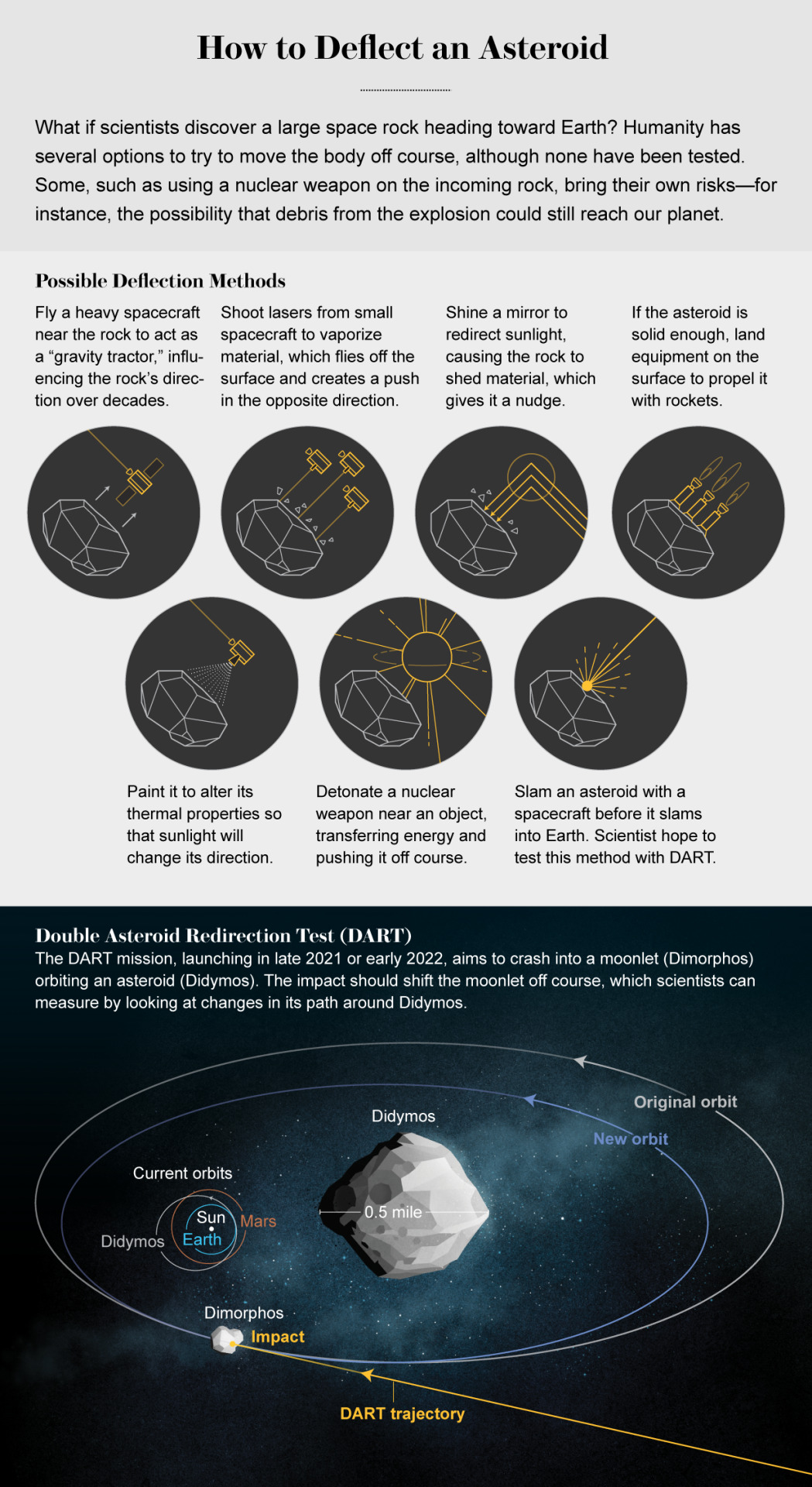
An asteroid must be tracked and studied after discovery.
It is important to support asteroid-hunting astronomers via Grants since the world's professional sky surveys cannot do all of this job on their own.
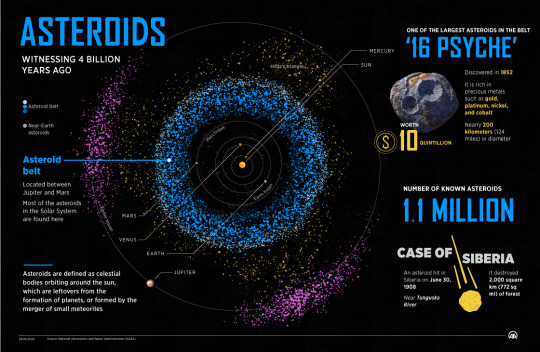
We can significantly lower the likelihood that our planet will be hit by a hazardous space rock by locating, tracking, and describing asteroids, and then testing deflection measures.

~ Jai Krishna Ponnappan
Find Jai on Twitter | LinkedIn | Instagram

#NASA#DART#Double Asteroid Redirection Test#Asteroid#Dimorphos#Asteroid Diversion#NEO#Near Earth Objects#Eart Protection#Space Weather
7 notes
·
View notes
Text

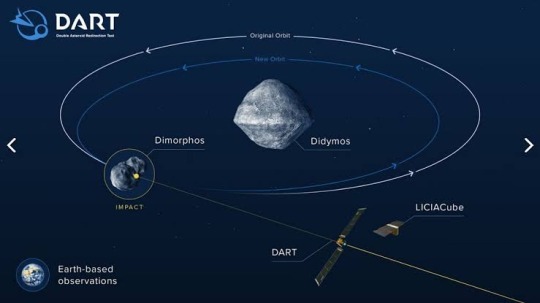
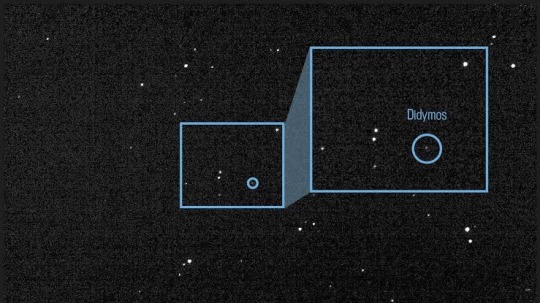
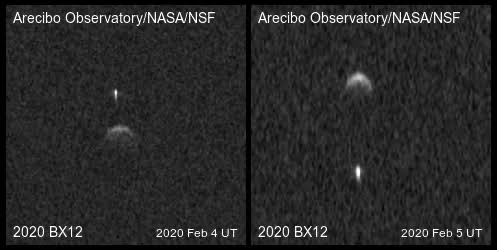
Double Asteroid Redirection Test (DART) is a NASA space mission aimed at testing a method of planetary defense against near-Earth objects (NEOs). Launched from Earth in November 2021, the mission will deliberately crash a space probe into the minor-planet moon Dimorphos of the double asteroid Didymos to assess the future potential of a spacecraft impact to deflect an asteroid on a collision course with Earth through a transference of momentum. The asteroid poses no actual threat to Earth; it was merely selected for the test. Impact- Tuesday 27/9 09:14 AEST
4 notes
·
View notes
Text
Happy birthday to 3753 Cruithne
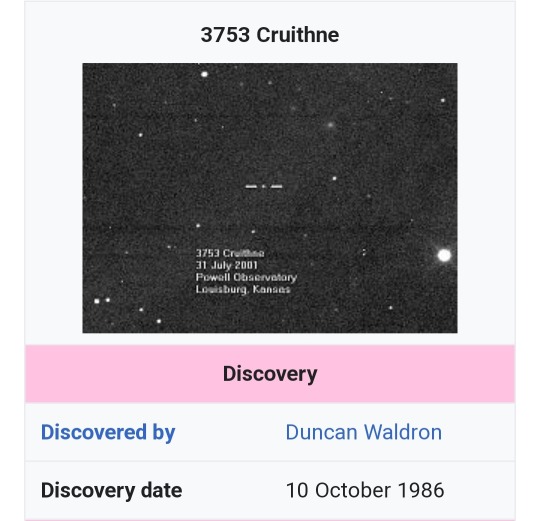
1 note
·
View note
Photo

Astronomy #Space #Espace #Astrometry
0 notes
Text
A new artificial intelligence algorithm programmed to hunt for potentially dangerous near-Earth asteroids has discovered its first space rock.
The roughly 600-foot-wide (180 meters) asteroid has received the designation 2022 SF289, and is expected to approach Earth to within 140,000 miles (225,000 kilometers). That distance is shorter than that between our planet and the moon, which are on average, 238,855 miles (384,400 km) apart. This is close enough to define the rock as a Potentially Hazardous Asteroid (PHA), but that doesn't mean it will impact Earth in the foreseeable future.
The HelioLinc3D program, which found the asteroid, has been developed to help the Vera C. Rubin Observatory, currently under construction in Northern Chile, conduct its upcoming 10-year survey of the night sky by searching for space rocks in Earth's near vicinity. As such, the algorithm could be vital in giving scientists the heads up about space rocks on a collision course with Earth.
Continue Reading.
63 notes
·
View notes
Text
1 note
·
View note
Text
Thales Alenia Space proporcionará equipos de comunicación a la misión NEO Surveyor de la NASA
El telescopio de la NASA que detectará asteroides potencialmente peligrosos para la Tierra
Continue reading Thales Alenia Space proporcionará equipos de comunicación a la misión NEO Surveyor de la NASA
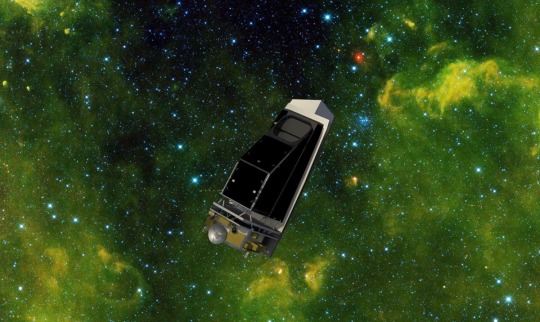
View On WordPress
#Asteroides#Ball Aerospace#cometas#Defensa planetaria#Equipos de comunicación#JPL#Laboratorio de Propulsión a Chorro#Leonardo#Misión espacial#Nasa#Near Earth Objects#NEO Surveyor#telescopio#Thales#Thales Alenia Space#TWTA
0 notes
Text
115 Years Ago: The Tunguska Asteroid Impact Event.
On June 30, 1908, an asteroid plunged into Earth's atmosphere and exploded in the skies over Siberia. Local eyewitnesses
0 notes